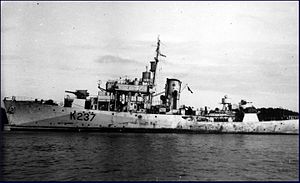HMCS Halifax (K237)
 HMCS Halifax, circa 1943–1945.
| |
| History | |
|---|---|
| Name | Halifax |
| Namesake | Halifax, Nova Scotia |
| Builder | Collingwood Shipyards Ltd., Collingwood |
| Laid down | 26 April 1941 |
| Launched | 4 October 1941 |
| Commissioned | 26 November 1941 |
| Decommissioned | 12 July 1945 |
| Identification | Pennant number: K237 |
| Honours and awards | Atlantic 1942–45[1] |
| Fate | Sold in 1945 as mercantile Halifax for use as salvage vessel |
| General characteristics | |
| Class and type | Flower-class corvette (Revised) |
| Displacement | 1,015 long tons (1,031 t; 1,137 short tons) |
| Length | 205 ft (62.48 m)o/a |
| Beam | 33 ft (10.06 m) |
| Draught | 15.7 ft (4.79 m) |
| Propulsion |
|
| Speed | 16 knots (29.6 km/h) |
| Range | 3,500 nautical miles (6,482 km) at 12 knots (22.2 km/h) |
| Complement | 85 |
| Sensors and processing systems |
|
| Armament |
|
HMCS Halifax was a Royal Canadian Navy revised Flower-class corvette which took part in convoy escort duties during the Second World War. She served primarily in the Battle of the Atlantic. She was named for Halifax, Nova Scotia.
Background
Flower-class corvettes like Halifax serving with the Royal Canadian Navy during the Second World War were different from earlier and more traditional sail-driven corvettes.
Corvettes commissioned by the Royal Canadian Navy during the Second World War were named after communities for the most part, to better represent the people who took part in building them. This idea was put forth by Admiral Percy W. Nelles. Sponsors were commonly associated with the community for which the ship was named. Royal Navy corvettes were designed as open sea escorts, while Canadian corvettes were developed for coastal auxiliary roles which was exemplified by their minesweeping gear. Eventually the Canadian corvettes would be modified to allow them to perform better on the open seas.[8]
Construction
Halifax was ordered as part of the Revised 1940–41 Flower-class building program. This revised program radically changed the look of the Flower-class corvette. The ships of this program kept the water-tube boilers of the initial 1940–41 program, but now they were housed in separate compartments for safety. The
Halifax was laid down by
War service
After arriving at Halifax 18 December, Halifax was initially assigned to the
After departing for her first refit in May 1943, Halifax returned to service in January 1944 with the
Post-war service
After the cessation of hostilities, Halifax was
Notes
- ^ "Battle Honours". Britain's Navy. Retrieved 31 August 2013.
- ^ Ossian, Robert. "Complete List of Sailing Vessels". The Pirate King. Retrieved 13 April 2011.
- ^ Fitzsimons, Bernard, ed. (1978). The Illustrated Encyclopedia of 20th Century Weapons & Warfare. Vol. 11. London: Phoebus. pp. 1137–1142.
- ISBN 0-517-67963-9.
- ISBN 0-8117-3275-4.
- ISBN 0-87021-913-8.
- ISBN 0-87021-450-0.
- ^ ISBN 1-55125-052-7.
- ^ a b "HMCS Halifax (K 237)". Uboat.net. Retrieved 1 September 2013.
- ^ ISBN 0-00216-856-1.
- ^ "Halifax (6111855)". Miramar Ship Index. Retrieved 13 July 2016.
